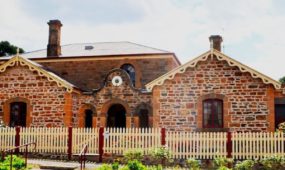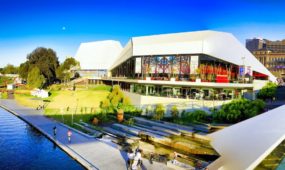Hotel dreaming with Tommy Watson
Arts
The concept of showcasing an individual artist’s work as a permanent retrospective exhibition in a hotel offers great appeal, but for the soon-to-be-launched Adelaide Art Series Hotel at Walkerville, the works of celebrated Indigenous artist Yannima Tommy Watson have also dictated its DNA.

Sign up to receive notifications about new stories in this category.
Thank you for subscribing to story notifications.
The fundamental and distinctive characteristics of The Watson Art Series Hotel reflect an “Australianness” that is quite profound in a large capital city.
Located in a refurbished 1960s office tower on the banks of the River Torrens, The Watson overlooks ancient gum trees and takes in the light of the north-western Adelaide plains – you can almost sense the country of Yanda, just outside Alice Springs, where Watson can often be found at work on his large colourful canvases.
The Watson offers total immersion in the artist’s work, housing the largest private collection of his contemporary Indigenous dot paintings in Australia, with 35 original works and 500 prints hung in both common and exclusive areas. The colours of each artwork are reflected in the furnishings and décor of the rooms in which they are presented.
“In my opinion, Mr Watson is one of the greatest living Indigenous artists,” says art consultant Ken McGregor, who was charged with the task of selecting the artists and works featured across the Art Series Hotel Group’s six boutique hotels in Victoria and The Watson in Adelaide.
“He is a master colourist and a storehouse of knowledge.”
Watson is believed to be about 79 years old. After his parents died when he was a young child, a relative adopted him and he spent his early life living in the traditional way, hunting and gathering from the land. From his adopted father, Nicodemus Watson, he also gained a deep understanding of his physical environment and its relationship to his own ancestral stories.
Like many Indigenous men of that time, Watson lived a semi-nomadic life, living off the land and working as a stockman and labourer. He began painting less than 20 years ago when other members of his community took it up and he thought he should try it.
“As soon as he started working, you could see that he was gifted,” says McGregor. “His gift is in the way he applies the paint, the way he makes patterns with the paint and the way he manipulates colour.”
In 2003, Watson was one of eight Indigenous artists – along with Paddy Bedford, John Mawurndjul, Ningura Napurrula, Lena Nyadbi, Michael Rile, Judy Watson and Gulumbu Yunupingu – who collaborated on a commission to provide works for the Musee du quai Branly in Paris. The Art Gallery of South Australia also features one of his works, Walpa (2004).
“He paints the stories and culture of his country – his ‘Tjukurrpa’,” explains McGregor.
“He knows the end of his life is coming and he’s trying to get everything out. He will tell you a story about any one of his paintings to keep you happy, but it’s his knowledge and it doesn’t belong to us.
“To us, his paintings are purely decorative. His use of strong, vibrant colour and complex composition creates an almost incandescent quality.
“As soon as I saw this site, I knew that Mr Watson’s work would be perfect for it – he is from the South Australia/Northern Territory border; it’s a nice connection.”
The Watson is currently operating with permanent and long-stay tenants in apartments and 24 hotel rooms. Staff are educated by the hotel curator in Watson’s art and the story behind each piece, so that they are able to pass on that knowledge to interested guests.
The complex is part of the Art Series Hotel Group owned by the Deague family, who are property developers and avid art collectors. Other hotels in the group include The Cullen at Prahran, named after Adam Cullen; The Olsen at South Yarra, named after John Olsen; The Blackman in Melbourne’s CBD, named after Charles Blackman; The Schaller Studio at Bendigo, named after Mark Schaller, and The Larwill Studio in Parkville, named after David Larwill.
When Watson visited the hotel last week to see his work hanging, he said it was “palya” (good).
This story first appeared on InDaily.
Jump to next article



